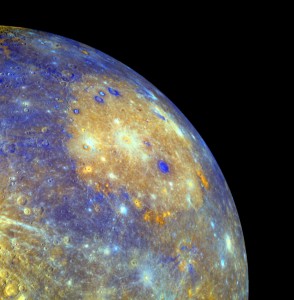
Analysis of data from the third and final fly-by of the MESSENGER spacecraft in September 2009 has revealed a treasure trove of new information on the solar system’s innermost planet. MESSENGER is on its way to Mercury, where it will settle into orbit in March 2011 and help scientists answer crucial questions about Mercury’s geology, density, structure, and magnetic field. Three fly-bys of the planet, spaced over twenty months, have been necessary to guide the spacecraft into its upcoming orbit around Mercury beginning in March 2011.
Bill McClintock, CU-Boulder’s Laboratory for Atmospheric and Space Physics and a Messenger mission co-investigator, said, “The focus of MESSENGER the science team has been on designing the observations, which will continue for a year after the spacecraft settles into orbit around Mercury. It may be a surprise to some that we’ve learned as much as we have from the three fly-bys, which were necessary to get the spacecraft into orbit.”
The new data reveals the first observations of emission from an ionized species in Mercury’s exosphere, information about magnetic substorms, and evidence of younger volcanism on Mercury than previously recognized. The results are reported in three papers published in the July 15 Science Express section of Science magazine online.
LASP developed and built the Mercury Atmospheric and Surface Composition Spectrometer (MASCS) onboard MESSENGER. MASCS is designed to detect minerals on Mercury’s surface and determine the abundance and components of its thin atmosphere. Data from MASCS will help answer the questions: What is Mercury’s surface made out of? How is Mercury’s atmosphere generated? And does Mercury have ice at its poles?



